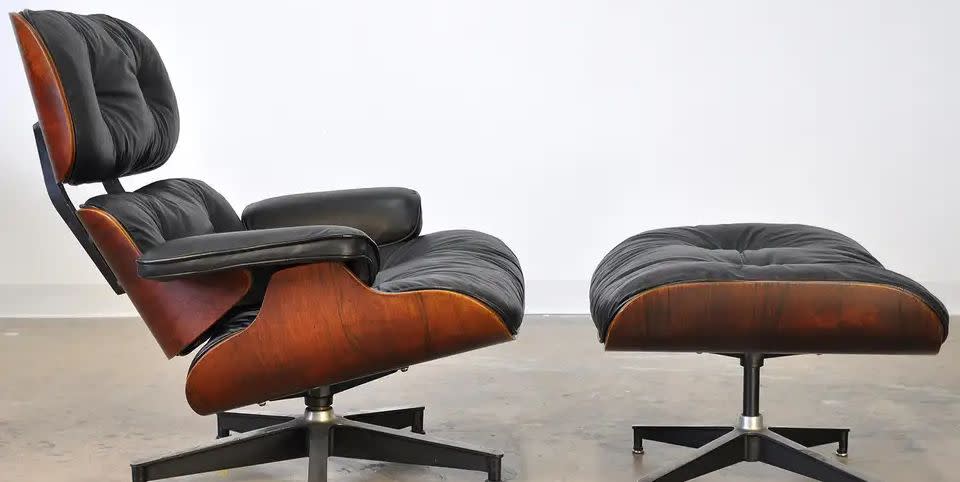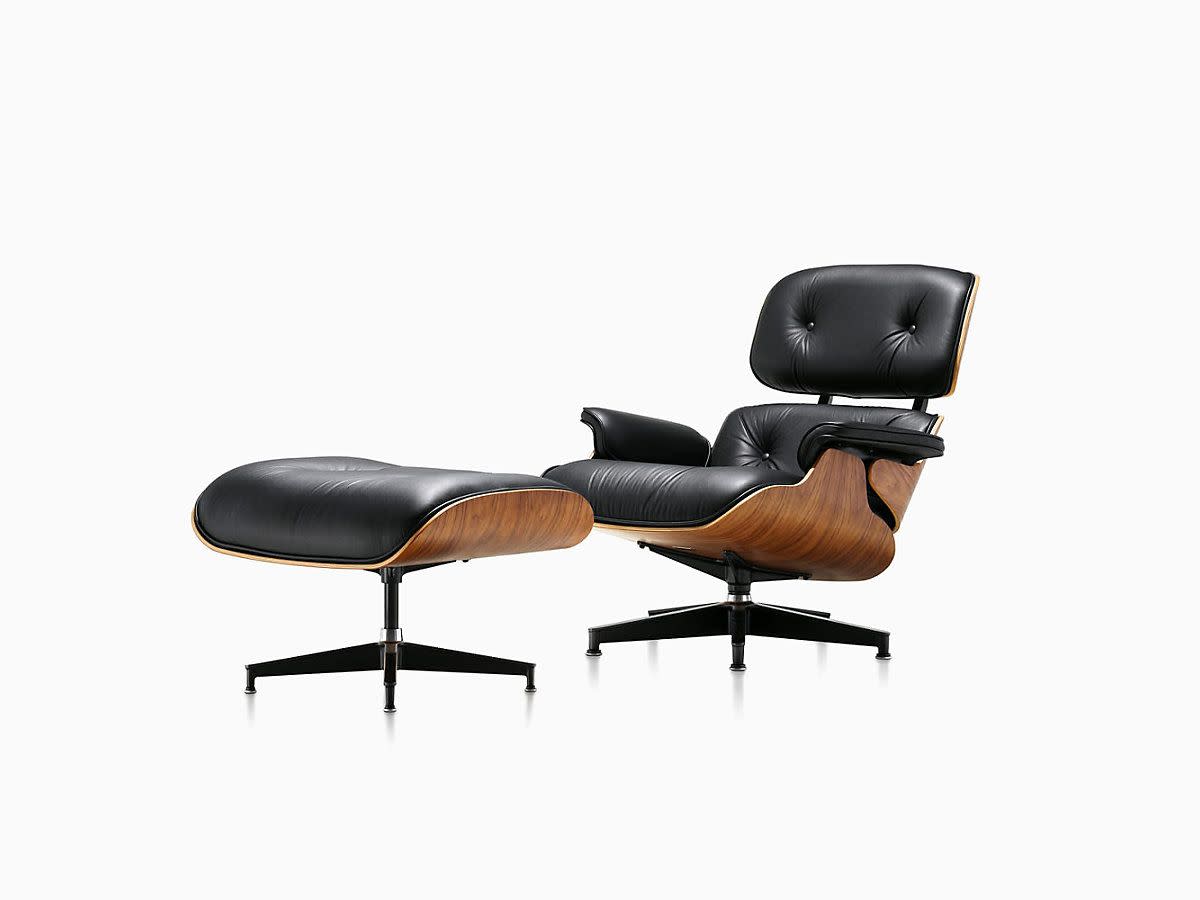Is That Actually Eames?

"Hearst Magazines and Yahoo may earn commission or revenue on some items through these links."
There's something almost enchanting about vintage pieces and antiques: They've had a whole life (or several) somewhere else before moving into your home; in a way, they're survivors of a bygone era. By dotting your space with older pieces here and there, you're basically preserving a small piece of history. Plus, aside from becoming the most sustainable and environmentally conscious way to shop for luxury furniture, antiquing guarantees uniqueness.
Here's the thing about vintage and antique furniture, though: It can be intimidating, courtesy of their high prices and backstories. Sometimes, they don't even come with the latter, which can make shelling out the big bucks for a piece you can't authenticate a hard sell.
Just because an ornately carved secretary desk made entirely of glossy oak or a hand-cut crystal chandelier may not come with maker's stamps doesn't mean it's not an authentic antique. We chatted with Anthony Barzilay Freund, editorial director and director of fine art at 1stDibs, and Benoist F. Drut, owner of Maison Gerard, (a New York gallery that specializes in old French furniture, lighting, and objets d'art), to find out how to ensure that that a piece you're investing in is the real deal.
Buy from a reputable source.
"Fakes are really the rare outliers and not the norm in the world of antiques and vintage furniture," Freund assures us. Still, he says, it's always best to investigate the reputation of individual dealers, or use a renowned online marketplace like 1stDibs that sells only vetted and authenticated items. "When buying any piece of furniture that purports to be old, it's important that you are working with a reputable dealer who has a history of handling the type of material and a track record of participating in vetted fairs or selling on digital platforms such as 1stDibs that monitor inventory," Freund explains. That way, you can trust the info you're given. As Freund says, "You can perform your due diligence by asking the dealer to provide you with any information about the piece's provenance (who made it, where was it made, and who owned it over the years)."
As for antique-hunting at thrift stores and flea markets, you may find a few quality pieces here and there, says Freund, "and the more you look, the better able you'll be to discern quality." So, browse often!
Look for a maker’s mark—when possible.
Many antiques from famed designers bear a stamp or signature indicating who made them—but many don't, and not all stamps can be trusted. One myth Drut wants to bust is that all authentic pieces feature a stamp or signature. "A piece that has a stamp may be an indication that it's by a specific designer, but there have been known cases in which some badly intentioned people use someone else's branding stamp to produce fakes," he explains. The prolific 18th-century French designer George Jacobs, for instance, was famous for his iconic stamps, but even he didn't mark every piece he designed with a signature, so "you can't rely entirely on the stamp to prove authenticity," Drut says. That being said, he adds, "it's usually obvious if it's a real stamp and not a copy."

If there's a brand you like, do some research first to uncover exactly what type of mark, if any, you should be seeking. One of the most popular vintage pieces is the beloved Eames lounge chair, and, according to the brand, which still produces some of the designer's original designs, "Labels and stamps can be the best and the quickest method of authenticating your Eames design. It may also help you to date and value your piece." Every Eames piece, from the earliest designs from the early 1940s to the ones produced now, bears a label. The only exception is the fiberglass shell chair, each of which bear a stamp. Both the labels and stamps feature a series of letters and numbers that may seem like gibberish but can actually determine the exact age of the piece.
Ask for documents of its provenance.
This may seem like the most straightforward step, but it's usually the least reliable for one key reason: "Pieces that are a few hundred years old move from place to place during their lifetime, and rarely do the papers follow them," Drut explains. In most cases, you simply have to decide whether or not you trust what the dealer is telling you to be true about a piece's provenance. Some items, however, do come with papers that can easily be authenticated. These pieces are typically ones that have been in the family's estate for generations.
Do your own research.
If you're considering an older piece, the dealer from whom you're buying it should have a general idea of the year or decade it was produced. With that information, do some digging about how similar pieces of furniture were made and with which types of materials. Drut instructs, "Look at books about that time period and, if you can, visit museums. It doesn't take a professional to see all of the subtle details—such as the materials used—that indicate if it's authentic or not." Plus, with the advent of the Internet, analyzing such details is easier than ever.
Along the way, you might uncover some lesser-known designers whose pieces are still genuine works of art, but may be easier to find and more affordable to purchase. (If you love Eames, for example, you might want to look into finding a Plycraft chair.) Just because something isn't crafted by a well-known individual or brand doesn’t mean it's not an authentic vintage or antique.
Do a “run-down” of materials and construction techniques.
Ask the dealer what the piece of interest is made of—the response will be another indicator of authenticity. Take chairs as an example. "Plenty of chairs and sofas made today are filled with foam," says Drut. "An 18th-century chair, however, will be filled with horsehair, as foam was not invented until much later in the 20th century."
Ask for pre-restoration photos.
"If the piece has been extensively cleaned and/or refinished," Freund advises, "ask to see pre-restoration photographs." Any reputable restorer enlisted by big-time dealers is likely to have a few on hand. Here's the thing about restorations: They're not a bad thing, and they're definitely not a reason to question a piece's authenticity or age. For instance, Drut says, if you're considering buying a 19th-century chair whose back leg is attached with glue, "that's because it's 200 years old and, without the glue, the chair may not be usable." Looking at an image of the chair before the glue was applied can reassure you that you're getting a strengthened original, not a fake.
On the other hand, if you find a centuries-old piece that looks spotless, "how can you explain that?" Drut asks. "You can't. An alleged antique that looks too good to be true probably is," Drut adds. Consider what an update may be concealing: "If something has been fully painted over, that often means that someone has something to hide. Stay away," warns Drut.
Accept flaws as adding character.
"Antiques and vintage pieces have a patina and personality that one cannot find in a newly constructed object," Freund notes. "Rather than viewing this as damage or wear and tear, antique-lovers think signs of age give an object a visual interest, warmth, and uniqueness that really enhances the character of a room."
Follow House Beautiful on Instagram.
You Might Also Like
